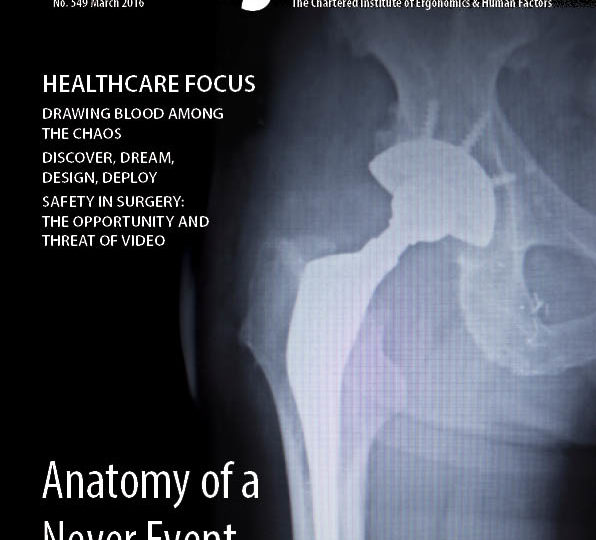
CIEHF President Claire Dickinson answers questions about the profession, its challenges and its future
1. How big a part will human factors professionals and ergonomists play in boosting the UK’s economy this year?
Our underlying economy is strong, but unsettled by what the future will look like outside the European Union. By ‘Designing for People’, which is the essential principle embraced by the discipline, human factors can make a major contribution to better work and life. Human factors practitioners are contributing to the way in which our manufacturing sector can increase efficiency and produce more desirable outputs, and by doing so attract further investment into UK manufacturing. Ergonomists are beginning to see their contribution recognised within the healthcare sector, especially in improving the design of medical devices. Introducing more imaginative ways of doing things and new approaches can make life better, longer and stronger. And in transport, human factors continues to contribute to safer, faster, more accessible rail travel in particular. So, manufacturing, healthcare and transport, three sectors using human factors information and practitioners that are benefiting society and human wellbeing.
2. What is the biggest impact ergonomics and human factors is making in UK society and what excites you about ergonomics and human factors developments in the coming year?
I think society as a whole is much more aware of good design and the introduction of new technology. It’s the feeling you get when things work well, first time, every time, and the joy you can feel when the design of something has clearly taken you, the user, into account. This plays into our hands to a great effect – given that ergonomics and human factors majors on researched, elegant, intuitive, imaginative ways of doing everyday things. Ergonomics is also about improving the way people interact with work equipment and new technology to keep us safe. And how we meet the challenges of the environment – dealing with new computerised systems, crowds, designing better signage, and ways of remaining secure. All of these examples improve human wellbeing, contribute to society’s ability to live better, more comfortably, more efficiently and safer. This is what excites me most.
3. What does the future hold of the profession?
We need to shout loud and hard about this science-based discipline to those in adjacent orbits: psychology, engineering, architecture, designers, facilities management, and show how impactful ergonomics and human factors can be. By doing that, we will grow in numbers, and by doing that we will differentiate more clearly what ergonomics and human factors delivers. Our standards too will need to reflect that society has moved increasingly toward specialisation of roles, whilst we as a body continue to reinforce the value of breadth. We will need to work hard to ensure that as a profession we recognise this potential conflict, which I believe we can recognise as the opportunity it is.
4. What’s the main challenge ergonomics and human factors professionals face right now?
Demonstrating the contribution of the profession to those who are as yet unconvinced. This will take investment, in time, reach, enthusiasm and patience. But, done well, this will reap significant rewards for those prepared to make that investment.
5. How does the work of British ergonomics and human factors professionals compare with the world and what can we learn from other countries?
We were the first emerging and are presently the fourth largest community of human factors specialists in the world. We operate in an industrialised society, as do the communities in the US, Canada and Australia who are ahead of us in population size and consequently membership numbers. The challenges in the industrialised societies are similar, the imperatives in the industrialising societies are rather different. We have learned, and can learn, from both, and there is a rich network for doing so, but my feeling is that we also have much to learn from the communities of user-experience design and broader design community closer to home.
6. What are the main priorities for you as CIEHF president?
First, an emphasis on doing: focussing on a handful of focused, specific activities that are linked to real opportunities in our environment. We are planning a second edition of ‘The Human Connection’, our case studies publication. We are looking at the development of training courses to advance progress through our membership gradings and also to the public, interested in learning what “ergonomically designed” really means. Second, support and encouragement for practitioners and members, promoting the benefits of their work. Ergonomists can be the difference in something being technically possible and something that is defined as essential and well-used – we need to celebrate this and promote this more strongly. And third, to engage members on a task and finish basis, contributing to short-term projects that pay off in a very tangible way. I think focus in those three areas will bring the dividends that would make me proud of my coming year.
7. Can you name a current large-scale project where ergonomics and human factors could make an impact and why?
We are seeing a renaissance of Infrastructure projects in the UK – Thames Tideway Tunnel, Crossrail, HS2, Northern Hub, road investment, EDF’s new nuclear power stations at Hinckley Point C, Sizewell C and Bradwell. Such projects create thousands of new jobs and this includes Ergonomists/Human Factors practitioners involved in the design of the infrastructure and operational design of the future.



